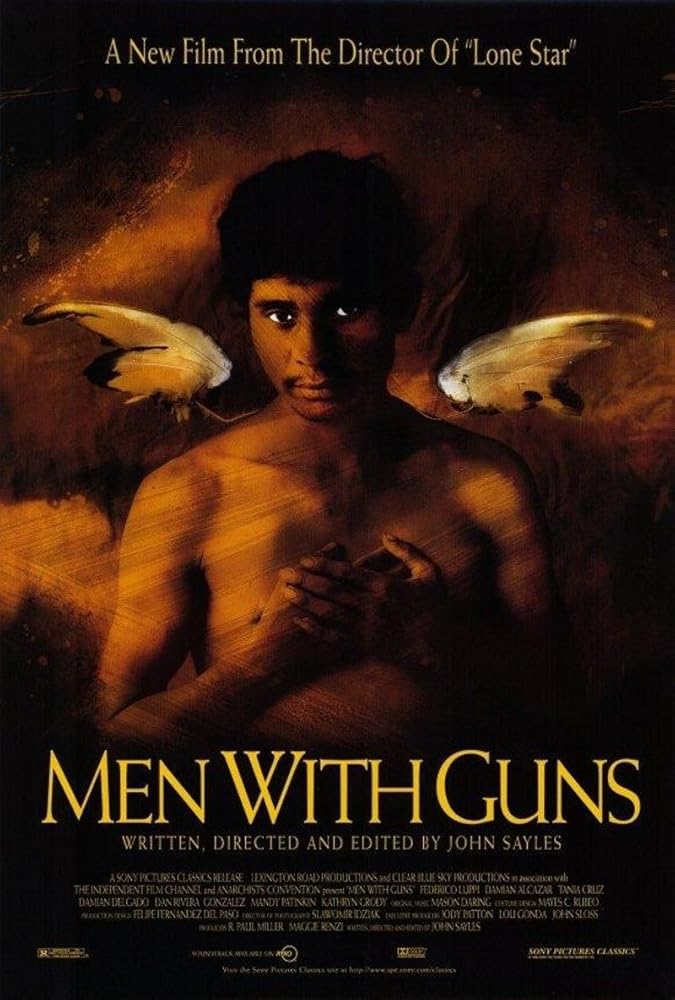
MEN WITH GUNS
(director/writer/editor: John Sayles; cinematographer: Slawomir Idziak; cast: Federico Luppi (Dr. Fuentes), Dan Rivera Gonzalez (Conejo, the boy), Damian Delgado (Domingo, the soldier), Tania Cruz (Graciela, the mute girl), Damian Alcazar (Padre Portillo, the priest), Mandy Patinkin (Andrew), Kathryn Grody (Harriet); Runtime: 128; Sony Pictures Classics; 1998-Mexico)
“This is a very strong, independent-minded picture.”
Reviewed by Dennis Schwartz
The world is a hard place to live in is the theme that runs through Sayles’ political drama about a capable upper-class but naive doctor from the city of some hypothetical Latin American country. The part of the doctor is played by the distinguished looking, white-haired Argentinean, Federico Luppi. He has trained some students to be doctors in the remote mountainous areas where the Indians live, under the auspices of a specially funded program. He hasn’t heard from them since they left his teaching program and is now anxious to visit them on his vacation and see how they are doing, before he retires. He takes his fancy 4-wheeler and makes the difficult trek to this impoverished region in order to see what his legacy will be. Luppi is concerned about leaving a legacy before he dies, as he is filled with pride about his accomplishments. But this pride turns to agony as Luppi slowly realizes that all the doctors he has trained have been assassinated and that he has sent them to their deaths by not preparing them for the realities of their job.
On Luppi’s journey to find the political truth the doctor picks up some traveling companions, who in turn add their tales of woe of living in such a bad political climate. From the orphan boy (Dan) he meets in the starving Indian village, he learns how little the people have and how ruthless both the army (which is made up of mostly Indian soldiers) and the guerrillas are. The guerrillas will kill anyone, whether they have a reason to or not. While the white plantation owners are seen as the exploiters of the people.
The boy turns out to be useful to the doctor because he speaks the native language, and he knows how to find his way in spots where there are no visible roads. The army deserter (Delgado) robs the doctor and then kidnaps him, and through the use of flashbacks we see how he was a medic in the army and participated in the violence and murder of the villagers.
A priest hitches a ride and tells his story of losing faith while working with the villagers, and no longer considers himself a priest. He does not see what good religion can do in such a repressive area, as the doctor questions him and states that a person must believe in something.
And finally, there’s a mute young lady who has been raped by the soldiers and subsequently has stopped speaking due to her personal trauma. She comes along with them hoping to find a secure place to live.
A talkative American couple (Mandy and Kathryn) is interested in the ancient civilization of this country, but are unable to comprehend what is going down for the current Indians living here. They become examples of all those tourists who should see what is taking place but can’t and this is because they can’t face what is right in front of them. They are living charmed lives and will return to their country unscathed by all the atrocities around them.
The doctor is the eyes and ears for what is going on. His slow but steady transformation into political awareness is the most reassuring omen sent out in this non-didactic, straight forward ambitious project of Sayles. He does not glorify the Indians, the ones who are the most cruelly treated. He shows them in the best and worst light, and of how hostile they can be to visitors. How when given a chance to get a better life they will do anything to escape, even kill their own people. The strength that comes from such a story, is in the telling of it and the powerful images presented. The problem is that since no specific country was named, it must mean that Sayles considers this to be a universal problem, This makes the problem gigantic, with no one to be specifically blamed. It, therefore, becomes difficult to zero in on what can be done to prevent such happenings. The other problem is that there is so little that can be done by individuals alone, that governments have to be held accountable for their actions. But, most of all, people have to learn how to help themselves.
This is a very strong, independent-minded picture, that chooses to tell a very difficult story, one that not many people will take comfort in.
REVIEWED ON 10/6/98 GRADE: B